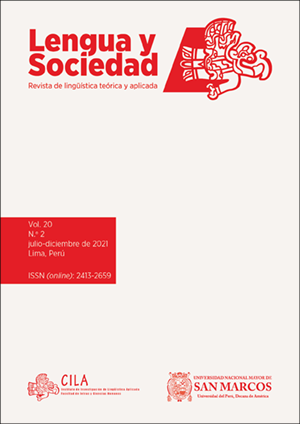Linguistic-semiotic analysis of humorous vignettes about covid-19
DOI:
https://doi.org/10.15381/lengsoc.v20i2.22242Keywords:
journalistic cartoons forms of humor, Covid-19 pandemic, cognitive linguistics, semiotic analysisAbstract
This article proposes an analysis matrix to identify the meanings and cognitive strategies used when developing humorous vignettes. The objective of the study is to linguistically and semiotically analyze the humorous cartoons of the main newspapers of the Metropolitan Lima press in times of pandemic. The research methodology is qualitative of the discourse analysis type. The results show the use of the type of black humor, the frequent use of implicatures and presuppositions within the pragmatic phenomena of discourse. The results also allowed us to observe that the linguistic innovations of the balloons and the graphic resources in the vignettes reflect the executive process in the thinking-meaning of the images with humorous intention. The main conclusion is that the linguistic-semiotic analysis of the iconoglossic discourse of the humorous cartoons made it possible to explain the sociopolitical situation of society due to Covid-19 and the ideology of the newspapers, as well as to determine the evidence of cognitive processes of language such as metaphor conceptual, conceptual metonymy and conceptual hyperbole. The use of the analysis matrix is recommended in the interpretation of discontinuous texts.
References
Afzal, N., Jabeen, I., Hameed, A. & Sheikh, A. (2021). Use of persuasion and newspapers’ representations of conflicts. Journal of Language and Linguistic Studies, 17(1), 398-411. https://doi.org/10.52462/jlls.24
Barthes, R. (2000). Mitologías, Madrid, Siglo XXI.
Castillo, V., Rada, M. & Almeida, D. (2019). El uso de las caricaturas en la prensa nacional, como estrategia comunicacional. Revista Caribeña de Ciencias Sociales. https://www.eumed.net/rev/caribe/2019/05/caricaturas-prensa-nacional.html
Eagleton, T. (1991). Ideology: an introduction. London: Verso. https://archive.org/stream/TerryEagleton-IdeologyAnIntroduction/TerryEagleton-Ideology-AnIntroduction_djvu.txt
Fairclough, N. (1992). Discourse and Social Change. Cambridge: Polity Press.
Grice, H. (1975). Logic and conversation. En P. Cole & J. Morgan (Ed.). Syntax and Semantics 3: Speech acts (pp. 41-58). Academic Press.
Iregui, P. (2021). El humor gráfico en tiempos de campaña: estudio de las viñetas políticas de Matador por medio del análisis crítico del discurso multimodal. [Tesis de grado]. Pontificia Universidad Javeriana. http://hdl.handle.net/10554/53492
Kövecses, Z. (2017). Levels of metaphor. Cognitive linguistics, 28(2), 321-347. https://doi.org/10.1515/cog-2016-0052
Kress, G. & van Leeuwen, T. (1996). Reading Images, the Grammar of Visual Design. Routledge.
León, C. (2020). Análisis semiótico de la columna de caricaturas del Diario Universo, durante el paro nacional del 2019 y su influencia en la opinión pública de los estudiantes del octavo semestre de Comunicación Social de la Universidad Técnica de Babahoyo. [Tesis de grado]. Universidad Técnica de Babahoyo. http://dspace.utb.edu.ec/handle/49000/7449
Loayza Maturrano, E. (2011). Análisis pragmático del código oral del transporte público urbano (‘lenguaje combi ’) en Lima Metropolitana. Lengua y Sociedad, 11(1), 91-100. https://doi.org/10.15381/lengsoc.v11i1.22658
Loayza Maturrano, E. (2013). Análisis pragmático de la jerga técnica de los estudiantes de Unalm. Lengua y Sociedad, 13(1), 155-167. https://doi.org/10.15381/lengsoc.v13i1.22632
Loayza Maturrano, E. (2020a). Análisis semiótico del lexicón de la comida peruana amazónica. ConCiencia EPG, 5(2), 90-109. https://doi.org/10.32654/CONCIENCIAEPG.5-2.6
Loayza Maturrano, E. (2020b). La investigación cualitativa en Ciencias Humanas y Educación. Criterios para elaborar artículos científicos. Educare et Comunicare, 8 (2), 56-66. https://doi.org/10.35383/educare.v8i2.536
Loayza Maturrano, E. (2021). Análisis lingüístico-cognitivo del discurso desde la gramática cognitiva. PURIQ, 3(2), 466-487. https://doi.org/10.37073/puriq.3.2.176
Martínez-Valencia, F. (2011). La caricatura editorial colombiana. Una perspectiva semántica y pragmática. Revista de Filología y Lingüística. Universidad de Costa Rica, 213-227. https://doi.org/10.15517/RFL.V37I1.2355
Medina, V. (2017). Análisis de los componentes semánticos y pragmáticos de la caricatura política panameña. [Tesis de Maestría]. Universidad de Panamá. http://up-rid.up.ac.pa/id/eprint/1496
Najafian, M. & Dabaghi, A. (2011). Hidden language of advertising: A semiotic approach. In Proceedings of the International Conference: Doing Research in Applied Linguistics, 20-26. https://arts.kmutt.ac.th/dral/PDF%20CD%20on%20Web/20-26_Hidden_Language_of_Advertising.pdf
Pierce, C. (1974). La ciencia de la semiótica. Nueva visión. http://107.152.36.151:8080/jspui/bitstream/123456789/152/1/PEIRCE-CH.-S.-La-Ciencia-de-La-Semi%c3%b3tica.pdf
Price C. & Devlin J. (2003). The myth of the visual word form area. Neuroimage, 19(3), 473-81. https://doi.org/10.1016/s1053-8119(03)00084-3
Saussure, F. (1916). Cours de linguistique générale. Publié par Charles Bally et Albert Sechehaye, avec la collaboration de Albert Riedlinger, Lausanne/París.
Saussure, F. (1971). Curso de Lingüística General. Traducción española de Amado Alonso, Buenos Aires, Losada. http://www.semiologia-cbc-distefano.com.ar/bibliografia/unidad-1/Saussure-1984-Curso-de-Linguistica-general.pdf
Tsakona, V. (2009 a). Language and image interaction in cartoons: Towards a multimodal theory of humor. Journal of Pragmatics, 41(6), 1171-1188. https://doi.org/10.1016/j.pragma.2008.12.003
Tsakona, V. (2009 b). Humor and image politics in parliamentary discourse: a Greek case study. Text & Talk, 29(2), 219-237. https://doi.org/10.1515/TEXT.2009.010
Vásquez, A. & Valencia, V. (2018). Análisis de la caricatura periodística referente al paro nacional de maestros de mayo de 2017. [Tesis de grado]. Universidad de Manizales. https://ridum.umanizales.edu.co/xmlui/handle/20.500.12746/3530
Yanes, A. (2012). Un acercamiento a la caricatura: algunas consideraciones semiósicas. Visitas al Patio, (6), 131–150. https://doi.org/10.32997/2027-0585-vol.0-num.6-2012-1671
Downloads
Published
Issue
Section
License
Copyright (c) 2021 Edward Faustino Loayza-Maturrano

This work is licensed under a Creative Commons Attribution 4.0 International License.
AUTHORS RETAIN THEIR RIGHTS
a. Authors retain their trade mark rights and patent, and also on any process or procedure described in the article.
b. Authors can submit to the journal Lengua y Sociedad, papers disseminated as pre-print in repositories. This should be made known in the cover letter.
c. Authors retain their right to share, copy, distribute, perform and publicly communicate their article (eg, to place their article in an institutional repository or publish it in a book), with an acknowledgment of its initial publication in the journal Lengua y Sociedad.
d. Authors retain theirs right to make a subsequent publication of their work, to use the article or any part thereof (eg a compilation of his papers, lecture notes, thesis, or a book), always indicating its initial publication in the journal Lengua y Sociedad (the originator of the work, journal, volume, number and date).



























